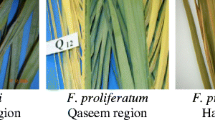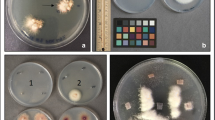Abstract
Fusarium diseases of Liliaceae crops cause significant losses worldwide. Yet some Fusarium species are found in planta without causing disease or even in a symbiotic relationship with its host. In this study we identified and characterized the Fusarium species isolated from soil, and from healthy and diseased bulbs of Lilium longiflorum grown in New Jersey and Oregon in the United States. The predominant Fusarium species from the Oregon location were F. solani (74%) and F. oxysporum (20%), whereas F. concentricum (43%) and F. proliferatum (26%), both belonging to the Gibberella fujikuroi species complex (GFSC), were the most commonly isolated species from New Jersey. To our knowledge, this is the first report of F. concentricum associated with Liliaceae. All of the isolates were characterized with sequences of the internal transcribed spacer and translation elongation factor 1-alpha genes. The 24 GFSC isolates were further characterized with mating type, mating population, and mycotoxin analysis. Results showed that all GFSC isolates were MAT-2, suggesting that the populations may be asexually reproducing in the region examined. The majority of the GFSC isolates produced beauvericin. Enniatin A, B, B1 and fusaproliferin were produced by a few isolates. Enniatin A1 and fumonisins were not detected in any of the isolates. Although F. oxysporum and F. solani are well-known bulb pathogens, many isolates of F. oxysporum and F. solani, and all of the F. concentricum and F. proliferatum were isolated from asymptomatic bulbs, suggesting their endophytic association with lilies.

Similar content being viewed by others
References
Baayen, R. P., Förch, M. G., Waalwijk, C., Bonants, P. J. M., Löffler, H. J. M., & Roebroeck, E. J. A. (1998). Pathogenic, genetic and molecular characterization of Fusarium oxysporum f. sp. lilii. European Journal of Plant Pathology, 104, 887–894.
Bald, J. G., & Solberg, R. A. (1960). Antagonism and synergism among organisms associated with scale tip rot of lilies. Phytopathology, 50, 615–620.
Bald, J. G., Suzuki, T., & Doyle, A. (1971). Pathogenicity of Fusarium oxysporum to Easter lily, Narcissus and Gladiolus. Annals of Applied Biology, 67, 331–342.
Bald, J. G., Paulus, A. O., & Lenz, J. V. (1983). Control of field root and bulb diseases of Easter lily. Plant Disease, 67, 1167–1172.
Barthélemy, J., & McMorris, F. (1986). The median procedure for n-trees. Journal of Classification, 3, 339–334.
Beckman, C. H. (1987). The nature of wilt diseases in plants. St. Paul: APS Press.
Bishop, D. L. (2002). Gene expression of a vascular peroxidase with stress induced pathogenesis in wheat sheaths. Physiological and Molecular Plant pathology, 61, 65–71.
Burgess, L. W., & Summerell, B. A. (1992). Mycogeography of Fusarium: Survey of Fusarium species from subtropical and semi-arid grassland soils from Queensland, Australia. Mycological Research, 96, 780–784.
Chelkowski, J., Ritieni, A., Wisniewska, H., Mulé, G., & Logrieco, A. (2007). Occurrence of toxic hexadepsipeptides in preharvest maize ear rot infected by Fusarium poae in Poland. Journal of Phytopathology, 155, 8–12.
D’Arco, G., Fernández-Franzón, M., Font, G., Damiani, P., & Mañes, J. (2008). Analysis of fumonisins B1, B2, and B3 in corn-based baby food by pressurized liquid extraction and liquid chormatography/tandem mass spectrometry. Journal of Chromatography. A, 1209, 188–194.
Desjardins, A. E., & Plattner, R. D. (2000). Fumonisin B1-nonproducing strains of Fusarium verticillioides cause maize (Zea mays) ear infection and ear rot. Journal of Agricultural and Food Chemistry, 48, 5773–5780.
Desjardins, A. E., Plattner, R. D., & Nelson, P. E. (1997). Production of Fumonisin B1 and Moniliformin by Gibberella fujkuroi from Rice from various Geographic areas. Applied and Environmental Microbiology, 63, 1838–1842.
Elmer, W. E., Johnson, D. A., & Mink, G. I. (1996). Epidemiology and management of the diseases causal to asparagus decline. Plant Disease, 80, 117–125.
Fotso, J., Leslie, J. F., & Smith, J. S. (2002). Production of Beauvericin, Moniliformin, Fusaproliferin, and Fumonisins B1, B2, and B3 by Fifteen Ex-Type Strains of Fusarium species. Applied and Environmental Microbiology, 68, 5195–5197.
Geiser, D. M., Gasco, M. J., Kang, S., Makalowska, I., Veeraraghavan, N., Ward, T. J., et al. (2004). Fusarium –ID v.1.0: A DNA sequence database for identifying Fusarium. European Journal of Plant Pathology, 110, 473–479.
Goloboff, P. (1999). NONA (NO NAME) ver. 2. Published by the author, Tucumán, Argentina.
Huelsenbeck, J. P., & Ronquist, F. (2001). MRBAYES: Bayesian inference of phylogeny. Bioinformatics, 17, 754–755.
Jestoi, M. (2008). Emerging Fusarium mycotoxins-fusaproliferin, beauvericin, enniatins and moniliformin-a review. Critical Reviews in Food Science and Nutrition, 48, 21–49.
Kulik, T., Pszczolkowska, A., Fordonski, G., & Olszewski, J. (2007). PCR approach based on the esyn1 gene for the detection of potential enniatin-producing Fusarium species. International Journal of Food Microbiology, 116, 319–324.
Leslie, J. F., & Summerell, B. A. (2006). The Fusarium lab manual (p. 388). Iowa: Blackwell Publishing.
Ligero, A. M. P., José, M., Ureba, B., & Vara, J. M. M. (2008). First report of Fusarium oxysporum f. sp. lilii and F. proliferatum affecting Lilium crops in Spain. Tropical Plant Pathology, 33, 235–236.
Nirenberg, H. I., & O’Donnell, K. (1998). New Fusarium species and combinations within the Gibberella fujikuroi species complex. Mycologia, 90, 434–458.
Nixon, K. C. (1999–2002). WinClada ver. 1.0000. Published by the author, Ithaca, NY, USA.
Nylander, J. A. A. (2004). MrModeltest v2. Program distributed by the author. Evolutionary Biology Centre, Uppsala University.
O’Donnell, K., Cigelnik, E., & Nirenberg, H. I. (1998). Molecular systematics and phylogeography of the Gibberella fujikuroi species complex. Mycologia, 90, 465–493.
O’Donnell, K., Nirenberg, H. I., Aoki, T., & Cigelnik, E. (2000). A multigene phylogeny of the Gibberella fujikuroi species complex: Detection of additional phylogenetically distinct species. Mycoscience, 41, 61–78.
Palmero, D., De Cara, M., Iglesias, C., Moreno, M. M., Gonzalez, N., & Tello, J. C. (2010). First report of Fusarium proliferatum causing rot of garlic bulbs in Spain. Plant Disease, 94, 277.
Petrini, O. (1991). Fungal endophytes of tree leaves. In J. H. Andrews & S. S. Hirano (Eds.), Microbial ecology of leaves (pp. 179–197). New York: Springer Verlag.
Proctor, R. H., Desjardins, A. E., & Moretti, A. (2010). Biological and chemical complexity of Fusarium proliferatum. In R. N. Strange & M. L. Gullino (Eds.), The role of plant pathology in food safety and food security (pp. 97–111). New York: Springer-Verlag, Inc.
Stankovic, S., Levic, J., Petrovic, T., Logrieco, A., & Moretti, A. (2007). Pathogenicity and mycotoxin production by Fusarium proliferatum isolated from onion and garlic in Serbia. European Journal of Plant Pathology, 118, 165–172.
Steenkamp, E. T., Wingfield, B. D., Coutinho, T. A., Zeller, K. A., Wingfield, M. J., Marasas, W. F. O., et al. (2000). PCR-based identification of MAT-1 and MAT-2 in the Gibberella fujikuroi Species Complex. Applied and Environmental Microbiology, 66, 4378–4382.
Walsh, J. L., Laurence, M. H., Liew, E. C. Y., Sangalang, A. E., Burgess, L. W., Summerell, B. A., et al. (2010). Fusarium: Two endophytic novel species from tropical grasses of northern Australia. Fungal Diversity, 44, 149–159.
White, T. J., Bruns, T., Lee, S., & Taylor, J. W. (1990). Amplification and direct sequencing of fungal ribosomal RNA genes for phylogenetics. In M. A. Innis, D. H. Gelfand, J. J. Sninsky, & T. J. White (Eds.), PCR protocols: A guide to methods and applications (pp. 315–322). New York: Academic Press, Inc.
Zhang, N., Geiser, D. M., & Smart, C. D. (2007). Macroarray detection of solanaceous plant pathogens in the Fusarium solani species complex. Plant Disease, 91, 1612–1620.
Acknowledgements
We would like to thank Lee Riddle, ELRF, Oregon, USA for supplying us with the commercial varieties of Easter lily bulbs grown in Oregon, and Dr. Richard Merritt, Rutgers University for the NJ grown bulbs. We thank Dr. John F. Leslie and the Fungal Genetic Stock Center (Kansas City, MO, USA) for the tester strains used to establish the mating experiment. We are also grateful to Dr. Kerry O’Donnell for providing us with reference strains of F. concentricum and for his valuable suggestions during the course of this study.
Author information
Authors and Affiliations
Corresponding author
Rights and permissions
About this article
Cite this article
Rajmohan, N., Gianfagna, T.J., Meca, G. et al. Molecular identification and mycotoxin production of Lilium longiflorum-associated fusaria isolated from two geographic locations in the United States. Eur J Plant Pathol 131, 631–642 (2011). https://doi.org/10.1007/s10658-011-9838-7
Accepted:
Published:
Issue Date:
DOI: https://doi.org/10.1007/s10658-011-9838-7




